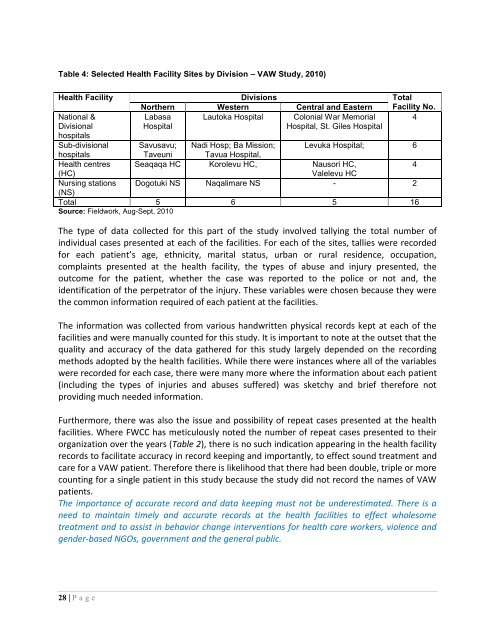Project Report â Fiji 2010 - Pacific Health Voices
Project Report â Fiji 2010 - Pacific Health Voices
Project Report â Fiji 2010 - Pacific Health Voices
You also want an ePaper? Increase the reach of your titles
YUMPU automatically turns print PDFs into web optimized ePapers that Google loves.
Table 4: Selected <strong>Health</strong> Facility Sites by Division – VAW Study, <strong>2010</strong>)<br />
<strong>Health</strong> Facility Divisions Total<br />
Northern Western Central and Eastern Facility No.<br />
National &<br />
Labasa Lautoka Hospital Colonial War Memorial 4<br />
Divisional<br />
Hospital<br />
Hospital, St. Giles Hospital<br />
hospitals<br />
Sub-divisional Savusavu; Nadi Hosp; Ba Mission; Levuka Hospital; 6<br />
hospitals<br />
Taveuni Tavua Hospital,<br />
<strong>Health</strong> centres Seaqaqa HC Korolevu HC, Nausori HC,<br />
4<br />
(HC)<br />
Valelevu HC<br />
Nursing stations Dogotuki NS Naqalimare NS - 2<br />
(NS)<br />
Total 5 6 5 16<br />
Source: Fieldwork, Aug-Sept, <strong>2010</strong><br />
The type of data collected for this part of the study involved tallying the total number of<br />
individual cases presented at each of the facilities. For each of the sites, tallies were recorded<br />
for each patient’s age, ethnicity, marital status, urban or rural residence, occupation,<br />
complaints presented at the health facility, the types of abuse and injury presented, the<br />
outcome for the patient, whether the case was reported to the police or not and, the<br />
identification of the perpetrator of the injury. These variables were chosen because they were<br />
the common information required of each patient at the facilities.<br />
The information was collected from various handwritten physical records kept at each of the<br />
facilities and were manually counted for this study. It is important to note at the outset that the<br />
quality and accuracy of the data gathered for this study largely depended on the recording<br />
methods adopted by the health facilities. While there were instances where all of the variables<br />
were recorded for each case, there were many more where the information about each patient<br />
(including the types of injuries and abuses suffered) was sketchy and brief therefore not<br />
providing much needed information.<br />
Furthermore, there was also the issue and possibility of repeat cases presented at the health<br />
facilities. Where FWCC has meticulously noted the number of repeat cases presented to their<br />
organization over the years (Table 2), there is no such indication appearing in the health facility<br />
records to facilitate accuracy in record keeping and importantly, to effect sound treatment and<br />
care for a VAW patient. Therefore there is likelihood that there had been double, triple or more<br />
counting for a single patient in this study because the study did not record the names of VAW<br />
patients.<br />
The importance of accurate record and data keeping must not be underestimated. There is a<br />
need to maintain timely and accurate records at the health facilities to effect wholesome<br />
treatment and to assist in behavior change interventions for health care workers, violence and<br />
gender-based NGOs, government and the general public.<br />
28 | P a g e
















